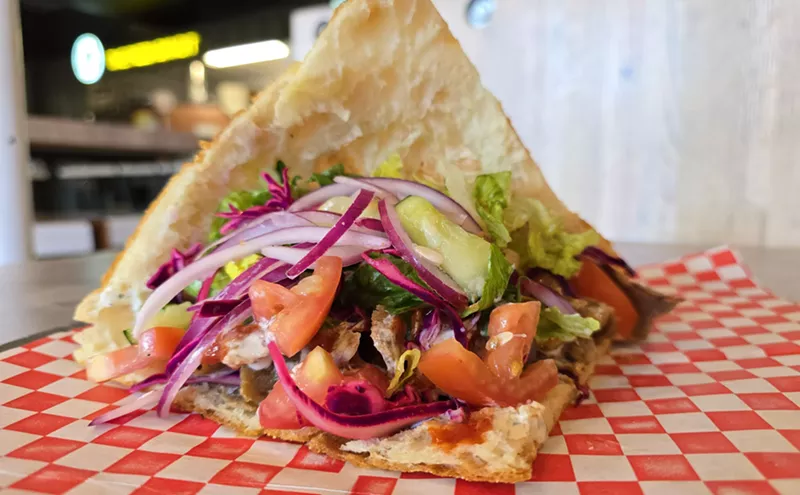There are mountains and deserts in Ethiopia. Cities and towns and long swaths of space where there's nothing at all. None of the names on the map meant anything to me. Ethiopia shares borders (and therefore foods and traditions) with Kenya and Somalia and Sudan -- all countries about which I know even less than I do Ethiopia. Ringed by mountains, Ethiopia has been protected to a certain extent throughout its history from the wars and invasions that invariably leave their non-indigenous stamp on a country's food long after the invasion is over. And still, traders and travelers made their mark on Ethiopia, bringing in chiles and ginger and subcontinental spices and walking away with coffee, the country's most important export.
Arada turns out to be the name of the central neighborhood of Addis Ababa, where one of the great spice markets of Africa, the Arada Gebeya, is located. Arada's namesake restaurant opened in 1998 on a stretch of Colfax busy with African restaurants, cafes and markets that reflect Denver's large expat Ethiopian and Eritrean communities. It did a good trade there, if not ever great, with a nice base of customers -- neighbors and immigrants and taxi drivers and gastronauts all sitting down together over plates of exactly the kind of food that made no sense to me at all. But last year, with rents rising on Colfax, the owners decided to move out of the familiar neighborhood and onto Santa Fe, another ethnic enclave entirely.
Which is where I found Arada that Saturday night.
I wasn't entirely ignorant of Ethiopian cuisine. I knew about injera, the most recognizable facet of Ethiopian dining, a slightly sour, squishy, soft, white flat bread made from fermented teff and served with everything, acting as side dish and silverware and plate. In taste and texture, injera is kind of like a gigantic underdone sourdough pancake. I'd also had azifa -- lentils marinated in vegetable oil with garlic, lemons and onion -- and kikil kitfo, which was, as far as I knew, pretty much just sautéed ground beef with muted spices, eaten folded inside pinches of injera like a sort of improvised African burrito.
But now, sitting with our backs to that map of alien names and flavors and chatting with owner Haime Asfaw about Arada's short, tight and unpronounceable menu, it suddenly occurred to me that what little I'd had of the foods of Ethiopia hadn't really been Ethiopian at all.
"The kitfo?" Laura asked. "Is that cooked or served raw?"
"Oh, no," Haime replied, shaking her head. "It is cooked. Unless I know you or if you are Ethiopian, I cook it for you."
"Wait a minute," I interrupted. "Is it supposed to be served raw?"
Haime smiled. "Well, for Ethiopia, yes. And very spicy."
Laura shook her head, knowing what was coming next.
"Can I have it that way?" I asked. "Ethiopian style?"
Now Haime laughed. "No," she said. "Really?"
"Really," I insisted.
Haime looked at Laura, as most people tend to when they can't quite believe I'm serious. Laura just shrugged. "It's okay," she said. "He means it. He eats things like that all the time."
Then Haime looked back at me, and I nodded vigorously, excited. "Absolutely," I said. "Bring it on."
And she did, proudly, beaming as she walked out platters and bowls of food, explaining every dish as it arrived at the table. We had sambusa, a cross between a pâtissier's turnover, an Indian samosa and a Jamaican meat pie -- triangles of crisp, flaky pastry wrapped around a heavily spiced beef filling turned green with fresh herbs and chopped nuts and tasting like beef covered in an Argentine chimichurri. The sambusa were delicious, served so hot that we burned our fingers pulling them apart. We washed down the flavors with sweet Ethiopian espresso and gulps of iced black tea spiked with clove.
One of the confusing things about Ethiopian cuisine is that everything tastes vaguely of something else, of some flavor you remember tasting somewhere else, at some other time. The spices -- most notably the berbere, ubiquitous in Ethiopian kitchens, a custom-blended spice mixture like Indian masala or Chinese five-spice that includes a little of everything: coriander and cumin, ginger and cardamom, nutmeg, clove, tumeric and cinnamon -- are somewhat Indian, somewhat Caribbean, but with a rawer edge. The sides -- unbelievably good stewed greens, carrots and green beans dressed in vinegar, cold cooked cabbage salad and another salad of fresh tomatoes studded with chunks of diced jalapeño -- are a mishmash of memories of American soul food and Island cuisine and even the green-market peasant grub of Europe.
Beef and chicken and lamb are all used, but no goat, no pork. Because of the particularly abstentious brand of Christianity practiced in the north of Ethiopia (with roughly 200 fasting days a year when no beef, chicken, eggs or dairy products may be consumed) and the Muslims in the south, vegetarian dishes are plentiful, with meatless variations available on almost any dish. There are rough cheeses that taste like paneer but have the curded texture of cottage cheese; they balance out the heat and spice of certain dishes as yogurt would if you were to eat your way east off that map on the wall. And though at first it seems as if you're chasing the flavors of a dozen different culinary traditions across the plate, what you're really doing is eating your way in toward just one. Ethiopian cuisine is a mother cuisine the way béchamel is a mother sauce: one from which infinite variation can be drawn, with a history of emigration rather than immigration, dispersion rather than assimilation. While Ethiopian cuisine remained almost untouched by foreign influence for generations, its flavors were brought to the Caribbean along the course of the slave trade. That hit of chimichurri memory is really a recollection of flavors that have existed for hundreds of years in Africa, then were brought to South America by an African diaspora in the same way that American soul food is a distant recollection of African traditions, a combination of flavors that were once native to a single place.
When the kitfo arrived, it was accompanied by its own theatrics of presentation. A large platter had been draped in injera, with pleated curtains of it hanging over the sides, and the borders of the tray were spotted with colorful cold salads and greens all made for mixing and dipping. With a large spoon, Haime scooped the beef -- raw like a tartare, cool to the touch and beautifully pink, shot with fierce veins of red -- from a small bowl onto the platter, added a scoop of cottage cheese, and shaped everything into a smooth mound. From another bowl, she then added doro alitcha -- rough chunks of chicken on the bone, stewed in a green sauce of vegetables and a million spices.
"Eat," she said, after explaining each component. She seemed reluctant to leave the table, lingering until I tore a piece of the spongy injera from the platter and picked up a large pinch of raw beef.
It was delicious, a pure kick of blood and protein topped with spiced Ethiopian butter and laced with the wicked heat of a smoky-hot chile that made it almost like a beef ceviche, the meat affected by the acidity of the chiles, the fire of the chiles both carried and muted by the fat in the beef, and the cottage cheese hanging over everything as a cooling, almost civilizing influence. I don't know if this was a good version of kitfo or a bad one, or how it might have stacked up against plates of kitfo made elsewhere in Denver or in Ethiopia, because it was a truly new taste for me. I'd never had anything like it before, nothing even close. But I know that I loved it, that it was one of those flavors that hits you in the back of the head like a lightning bolt of comprehension -- you suddenly get it and understand that this plate, this dish in particular, is one of those very rare opportunities to taste the backbone of a cuisine. Like eating your first raw oyster, your first perfect San Marzano sauce, your first piece of sashimi, to eat kitfo for the first time is to taste the history of food in one of its purest forms. I was almost through a half-pound of bloody, raw, chile-shot beef with peasant cheese before I even started to slow down.
Haime returned to our table again and again, checking on us, making sure that everything was to our liking. She told me that if I was getting full, I didn't need to eat the meat with injera, that the kitfo could just be picked up with the fingers. She told us how the greens were made (with garlic and salt and cardamom and long, slow cooking) and how the clove in the iced tea numbed the tongue just slightly against the worst assault of the spiciest dishes. She explained berbere, weighed the virtues of the doro alitcha against the more traditional doro wat (literally translated, that dish is "chicken in sauce," which just means chicken and red-pepper sauce cooked down until one melts into the other). After so many years, I finally had my native guide, swollen with happiness at the opportunity to explain her food, and thereby her culture, to someone so obviously starving for it.
And through it all, I never stopped eating. Your first time at anything only comes around once, and I wanted to make the most of it. So I ate until I could barely move: tearing at the injera, getting beef blood under my fingernails and wat on my shirt. When every dish was empty, Haime brought us ice cream drizzled with chocolate sauce and two spoons. After a journey of four years just to get to the beginning of one real dinner, and then the experience of that dinner, the ice cream was like a postcard from home -- a taste of the familiar among flavors of the far away.
I ate it with relish, already planning in my head when I could return to Arada for more.












